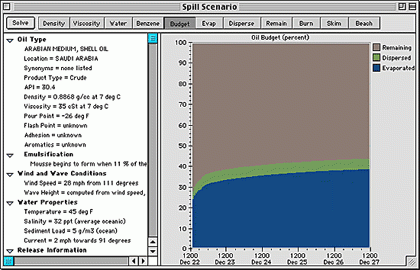Desktop ADIOS
ADIOS® (Automated Data Inquiry for Oil Spills) is NOAA's oil weathering model. It's an oil spill response tool that models how different types of oil weather (undergo physical and chemical changes) in the marine environment. Working from a database of more than a thousand different crude oils and refined products, ADIOS quickly estimates the expected characteristics and behavior of spilled oil.
| Note: This desktop version of NOAA’s oil weathering model, ADIOS, has been replaced by two products. ADIOS's oil weathering capabilities have been incorporated in WebGNOME, part of the GNOME Suite of oil spill modeling tools. ADIOS's oil database has been captured and expanded in the ADIOS Oil Database. Desktop ADIOS has not been updated since August 2016 and will be retired in the coming months. |
Its predictions are designed to help decision-makers develop cleanup strategies based on estimates of how long spilled oil will remain in the environment.
For example, if the people responding to an oil spill want to know:
- Can the spilled oil still be dispersed with chemical dispersants? ADIOS can help answer this by predicting changes in an oil's viscosity (resistance to flow) over time.
- If 1,000 gallons of crude oil have spilled, will more than 1,000 gallons of oil-and-water mixture need to be cleaned up and disposed of? If so, how many more gallons? ADIOS can offer an answer by predicting how quickly a particular type of oil's water content will increase over time.
How It Works
ADIOS asks for information on the spill itself, environmental conditions, and the planned cleanup strategy. The program provides you with a best-guess answer and was designed to run on as little information as possible, especially the type of information that can be estimated quickly or obtained in the field. This could be wind speed(s), wave heights, water temperature, and water salinity; the type and amount of oil or product spilled; and the rate and duration of the release.
The ADIOS database includes estimates of the physical properties of oils and products. It then uses this information and mathematical equations to predict changes in those properties once the oil has been released. Such properties include the density, viscosity, and water content of an oil or refined product; and the rates at which it evaporates from the sea surface, disperses into the water column, and forms oil droplets that become emulsified, or suspended, in the water. The database was compiled from a variety of sources, including Environment Canada, the U.S. Department of Energy, and industry.
The program includes models to estimate the effects of common cleanup techniques, such as chemically dispersing, skimming, or burning the oil, and it now accounts for environmental processes, such as sedimentation. It also includes an expanded online help section and electronic manual.
ADIOS will make predictions for a maximum of five days. After five days, other processes, such as biodegradation and photo-oxidation, may be important, and the program does not model these processes.
Note: ADIOS does not run on Mac computers with Intel microprocessors. The Mac version of ADIOS is a Mac Classic application.
More Information about Weathering
What Is Weathering? Learn what happens to oil when it interacts with the physical environment by looking at the example of the 1989 Exxon Valdez oil spill.
Questions: Contact us with your questions, comments, or suggestions for ADIOS.
 An official website of the United States government.
An official website of the United States government. 
